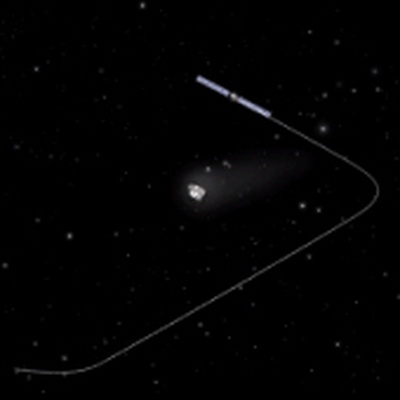What’s happening in Rosetta mission control today
We now have just one final burn of around 1 m/s that will slow Rosetta and kick it onto the first of the comet orbit arcs (see video below). This will take place on Wednesday, which will also be celebrated as the official ‘arrival day’ at ESOC with a formal programme and media briefing (you can follow via webcast).
The Rosetta Flight Control Team (FCT) are very busy, as today marks the first day in a new weekly work cycle that will see thruster burns taking place on Wed/Sun well into 2015.
Rosetta will, follow, at least for now, a three-legged triangular orbit that requires a small thruster burn at each apex. The legs are about 100 km long and it will take Rosetta between three and four days to complete each one.
Under the new cycle, for the Wednesday burn, Mondays will be the planning day (for Sunday burns, it will be Thursday). Planning day means an intense round of activity not only for the FCT, but also for the flight dynamics teams.
Late in the day, by 20:00CEST, flight dynamics will deliver all their products required for the coming cycle (based on their analysis of the resulting orbit and the preceding burns) to the FCT, who will merge this with other products (including instrument activities coming from the Rosetta Science Operations Centre at ESAC – see comment at end), make sure all activities are conflict free and generate the stack of commands that must be uploaded to carry it all out.
The FCT are also busy generating plans and data related to the ground stations and other systems used to control Rosetta. This involves a great deal of checking, cross-checking and time-line updating, as well as resolving any conflicts that are found.
To get an idea of how tight the schedule is, note that the set of commands on board Rosetta now expire at 12:00 CEST Tuesday, 5 August. In other words, if nothing else is done, Rosetta would run out of instructions tomorrow at lunch time!
So, the next set of commands, including the Wednesday burn commands, must be readied and then uploaded tonight overnight.
This next set will cover the timeframe 12:00 CEST Tuesday to 12:00 CEST Friday. The cycle then repeats for the Sunday burn.
And this very brief description relates only to the FCT activities; in parallel, the Rosetta Science Operations Centre at ESAC must also generate a complex set of instructions for the instruments, which also must be planned and uploaded on a very tight schedule.
